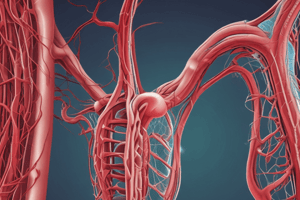Podcast
Questions and Answers
What is the most common disease of the arteries?
What is the most common disease of the arteries?
- An aneurysm rupture
- Atherosclerosis
- Thickening of muscle fibers
- Arteriosclerosis (correct)
Which regulatory mechanism plays the most important role in regulating the caliber and blood flow of peripheral blood vessels?
Which regulatory mechanism plays the most important role in regulating the caliber and blood flow of peripheral blood vessels?
- Central nervous system influences
- Circulating hormones and chemicals
- Sympathetic (adrenergic) nervous system activity (correct)
- Independent activity of the arterial wall
What are some common symptoms of peripheral vascular diseases?
What are some common symptoms of peripheral vascular diseases?
- Diminished pulse and edema
- Diminished pulse and pain
- Skin changes and possible edema
- Pain and skin changes (correct)
What type of disorder causes ischemia and tissue necrosis due to chronically progressive pathologic changes to the arterial vasculature?
What type of disorder causes ischemia and tissue necrosis due to chronically progressive pathologic changes to the arterial vasculature?
What is the main cause of arterial disorders resulting in ischemia and tissue necrosis?
What is the main cause of arterial disorders resulting in ischemia and tissue necrosis?
Which of the following is a characteristic of atherosclerosis?
Which of the following is a characteristic of atherosclerosis?
What is a nursing management approach for improving peripheral arterial circulation?
What is a nursing management approach for improving peripheral arterial circulation?
What is a common nursing management approach for varicose veins?
What is a common nursing management approach for varicose veins?
What is a symptom of peripheral arterial insufficiency?
What is a symptom of peripheral arterial insufficiency?
What causes varicose veins?
What causes varicose veins?
Study Notes
Cardiovascular Diseases
- The most common disease of the arteries is atherosclerosis.
Regulation of Peripheral Blood Vessels
- The autonomic nervous system plays the most important role in regulating the caliber and blood flow of peripheral blood vessels.
Peripheral Vascular Diseases
- Common symptoms of peripheral vascular diseases include:
- Pain or cramping in the legs, thighs, or buttocks during physical activity
- Numbness, weakness, or heaviness in the legs
- Coldness or discoloration of the skin
- Weak or absent pulses in the legs
- Ulcers or wounds that won't heal
Ischemia and Tissue Necrosis
- Atherosclerosis is a type of disorder that causes ischemia and tissue necrosis due to chronically progressive pathologic changes to the arterial vasculature.
- The main cause of arterial disorders resulting in ischemia and tissue necrosis is atherosclerosis.
Characteristics of Atherosclerosis
- A characteristic of atherosclerosis is the buildup of plaque in the arterial walls, leading to hardening and narrowing of the arteries.
Nursing Management Approaches
- A nursing management approach for improving peripheral arterial circulation is to promote regular exercise, such as walking, to improve blood flow.
- A common nursing management approach for varicose veins is to recommend elevating the affected limbs and using compression stockings.
Peripheral Arterial Insufficiency
- A symptom of peripheral arterial insufficiency is intermittent claudication, which is pain or cramping in the legs during physical activity.
Varicose Veins
- Varicose veins are caused by prolonged increased pressure and dilation of the veins, often due to weakened valves or vein walls.
Studying That Suits You
Use AI to generate personalized quizzes and flashcards to suit your learning preferences.
Description
Learn about peripheral circulation and vascular disorders, including circulatory insufficiency of the extremities, arterial disorders, and venous disorders. The content covers the regulatory mechanism of peripheral vessels, central nervous system influences, and sympathetic nervous system activity.



